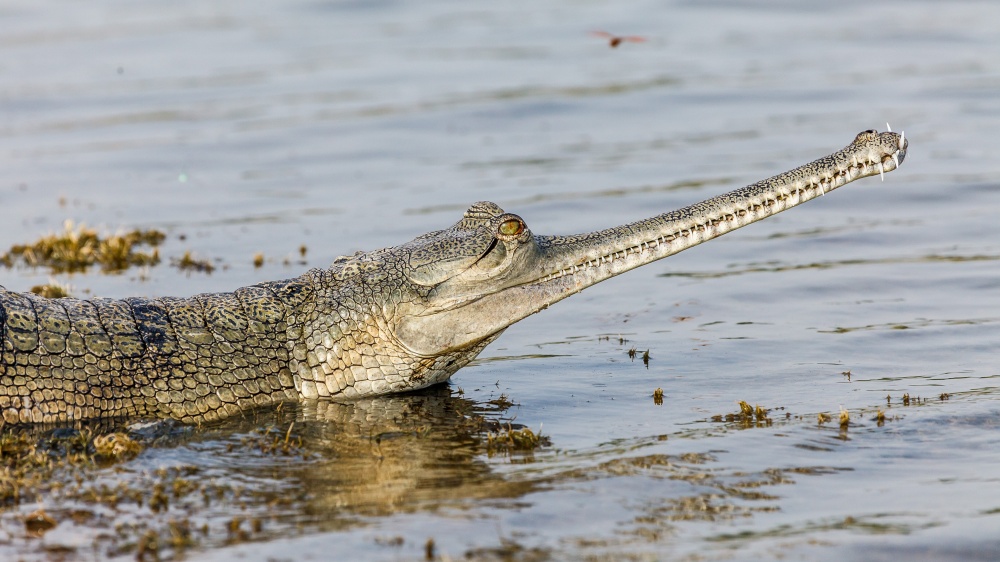Gharial – Gavial – Conservation in India
Conserving iconic species which have been endangered due improper land use, hunting, poaching and destruction of habitats in ecosystems that support them is akin to tiger conservation.
Most of the rivers in the country are subject to exploitation especially by the sand mafia which is somehow able to dither the corrective actions of State level dispensations. Siltation is proving to be a major threat to all aquatic species.
The first time I saw this enigmatic species was at Jim Corbett Tiger Reserve in Uttrakhand Northern India. It was a short visit and most of our drives where at Dhangadi gate in Dhikala Zone. We had stayed at enchanting Sarp Duli rest house and a fantastic beginning was made on our arrival. Down below besides fresh tiger paw prints was a lone marsh crocodile basking on the shore in that cold winter morning.
 |
| Photo Gharial – Margret Norah |
In that August sunlight, I could photograph the crocodile from close quarters thanks to security provided by a forest guard. That was it, my visit had begun with close encounters with Gharial’s cousin the marsh or fresh water crocodile. Though nowhere as endangered, all unique life forms in India are under the severe threat of extinction or near extinction thanks to our ways and the marginalised ecosystems.
 |
| Pair Gavial – Margret Norah at Chambal |
 |
| Marsh Crocodile – Margret Norah |
All ecosystems are under threat waiting for a policy rejuvenation that accords greater protection to the beleaguered species and their habitats. Though the Project Tiger Program under the aegis of Central Government is doing reasonably well another conservation initiative is moving forward. The Gharial conservation program with assistance of breeding centers is repopulating the rivers with historical evidence of the species as far as Punjab.
In post independent India the threat arose from hunting and poaching for leather which is valued as raw materiel for shoes and bags to name a few. All reptilian species are subject to severe threat of commercial exploitation thanks to the demand of soft leather products globally.
Though the Wildlife Protection Act 1972 has been effective in thwarting the demise of this species endemic to Indian Sub Continent, the number were still going down. This called for urgent conservation measures and the Indian Government responded.
 |
| Basking Gharials – Margret Norah |
My second encounter with the Gharial was at Chambal River Sanctuary which is spread across three states namely Uttar Pradesh, Madhya Pradesh and Rajastahan. At that time I was leading overseas birding groups for DMC called Indiafootprints. Frequent bird watching forays lead to witnessing the activities of this critically endangered species from close quarters. This along with experience of a shared of habitat in the pristine river between gharial, crocodiles, Ganges Dolphin and numerous species of turtles not forgetting the enchanting avian that make the river their home. As a matter of fact the birding possibility here is fascinating with plethora or species inhabiting the aquatic realm.
The Gavial is a fish eating species and survives in aquatic systems with deep burrows that retain water even during the scorching summers. It survives entirely on fish and is not known to harm humans. The length can be as much as eighteen meters. The body requires thermo-regulation fetching them to the river shores where they are most susceptible.
At Corbett and Chambal, the aquatic species are doing well. On my tour to Panna National Park, I could visit the Ken River but unfortunately could not see the gharial here because of location being far away and they survive precariously in a small pocket. Ken River Habitats like Panna National Park are severely stressed out due to mining especially the diamond mining at very close distance. Tigers have been successfully rehabilitated here and the crocodile species are eagerly waiting for their turn. The species once survived in Indus, Ganges, Brahmaputra and Irrawaddy Rivers systems in the subcontinent.
At Chambal River devoid of pollution they are less subjected to heavy metal exposure and the insidious fishermen’s net. They are also exploited by egg consumers, trophy hunters and widespread encroaching on the aquatic systems in order to create dams, barrage, irrigation canals and embankments that cut short their movement and restrict them to small nonviable shallows.
Most of the endemic species are very much susceptible to extinction due to stock limits that arises from reduction in numbers caused by numerous factors. This is a a global phenomena and not limit to India.
The reason behind the successful rehabilitation of gavial is the establishment of breeding centers in the country. This begins with collection of eggs from the rivers where the species is present and then rearing them in large numbers in the centers. After a certain post hatching they are rehabilitating back into the aquatic systems that they frequented.
One of the major rehabilitation center is situated in Kukrail near Lucknow erstwhile domain of Nawabs. Another rehabilitation center is the Madras Crocodile Bank situated in Chennai run by famous herpetologist Romuous Whittaker and his wife Jai.
Saving Gharials Using Religious Significance
Wikipedia Article on Conservation Gavial Morphology Status & Conservation in India
===========================
Uday Works as Freelance Naturalist and Blogs on conservation, tigers, environmental issues.
He also provides SEO and Website Contents in English. He teaches Digital Marketing in Jabalpur in Summers.
He can be contacted at:
Mail: pateluday90@hotmail.com
Mob: 09755089323


